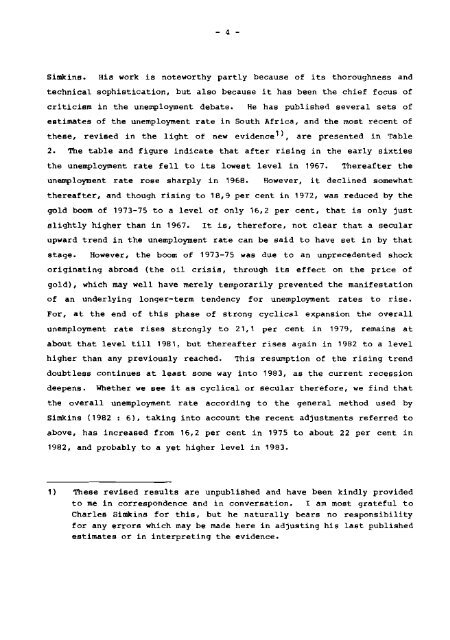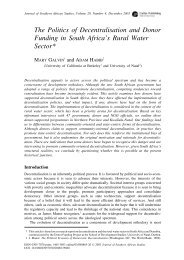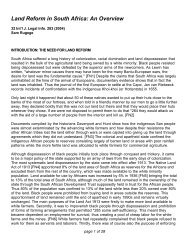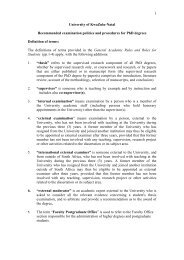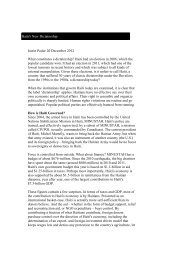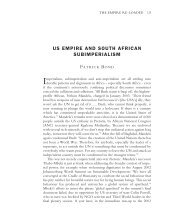Bell, Trevor : Unemployment in South Africa
Bell, Trevor : Unemployment in South Africa
Bell, Trevor : Unemployment in South Africa
Create successful ePaper yourself
Turn your PDF publications into a flip-book with our unique Google optimized e-Paper software.
Simk<strong>in</strong>s. His work is noteworthy partly because of its thoroughness and<br />
technical sophistication, but also because it has been the chief focus of<br />
criticism <strong>in</strong> the unemployment debate. He has published several sets of<br />
estimates of the unemployment rate <strong>in</strong> <strong>South</strong> <strong>Africa</strong>, and the most recent of<br />
these, revised <strong>in</strong> the light of new evidence1', are presented <strong>in</strong> Table<br />
2. The table and figure <strong>in</strong>dicate that after ris<strong>in</strong>g <strong>in</strong> the early sixties<br />
the unemployment rate fell to its lowest level <strong>in</strong> 1967. Thereafter the<br />
unemployment rate rose sharply <strong>in</strong> 1968. However, it decl<strong>in</strong>ed somewhat<br />
thereafter, and though ris<strong>in</strong>g to 18.9 per cent <strong>in</strong> 1972, was reduced by the<br />
gold boom of 1973-75 to a level of only 16.2 per cent, that is only just<br />
slightly higher than <strong>in</strong> 1967. It is, therefore, not clear that a secular<br />
upward trend <strong>in</strong> the unemployment rate can be said to have set <strong>in</strong> by that<br />
stage. However, the boom of 1973-75 was due to an unprecedented shock<br />
orig<strong>in</strong>at<strong>in</strong>g abroad (the oil crisis, through its effect on the price of<br />
gold), which may well have merely temporarily prevented the manifestation<br />
of an underly<strong>in</strong>g longer-term tendency for unemployment rates to rise.<br />
For, at the end of this phase of strong cyclical expansion the overall<br />
unemployment rate rises strongly to 21.1 per cent <strong>in</strong> 1979, rema<strong>in</strong>s at<br />
about that level till 1981, but thereafter rises aga<strong>in</strong> <strong>in</strong> 1982 to a level<br />
higher than any previously reached. This resumption of the ris<strong>in</strong>g trend<br />
doubtless cont<strong>in</strong>ues at least some way <strong>in</strong>to 1983, as the current recession<br />
deepens. Whether we see it as cyclical or secular therefore, we f<strong>in</strong>d that<br />
the overall unemployment rate accord<strong>in</strong>g to the general method used by<br />
Simk<strong>in</strong>s (1982 : 6). tak<strong>in</strong>g <strong>in</strong>to account the recent adjustments referred to<br />
above, has <strong>in</strong>creased from 16.2 per cent <strong>in</strong> 1975 to about 22 per cent <strong>in</strong><br />
1982, and probably to a yet higher level <strong>in</strong> 1983.<br />
1) These revised results are unpublished and have been k<strong>in</strong>dly provided<br />
to me <strong>in</strong> correspondence and <strong>in</strong> conversation. I am most grateful to<br />
Charles Simk<strong>in</strong>s for this, but he naturally bears no responsibility<br />
for any errors which may be made here <strong>in</strong> adjust<strong>in</strong>g his last published<br />
estimates or <strong>in</strong> <strong>in</strong>terpret<strong>in</strong>g the evidence.


